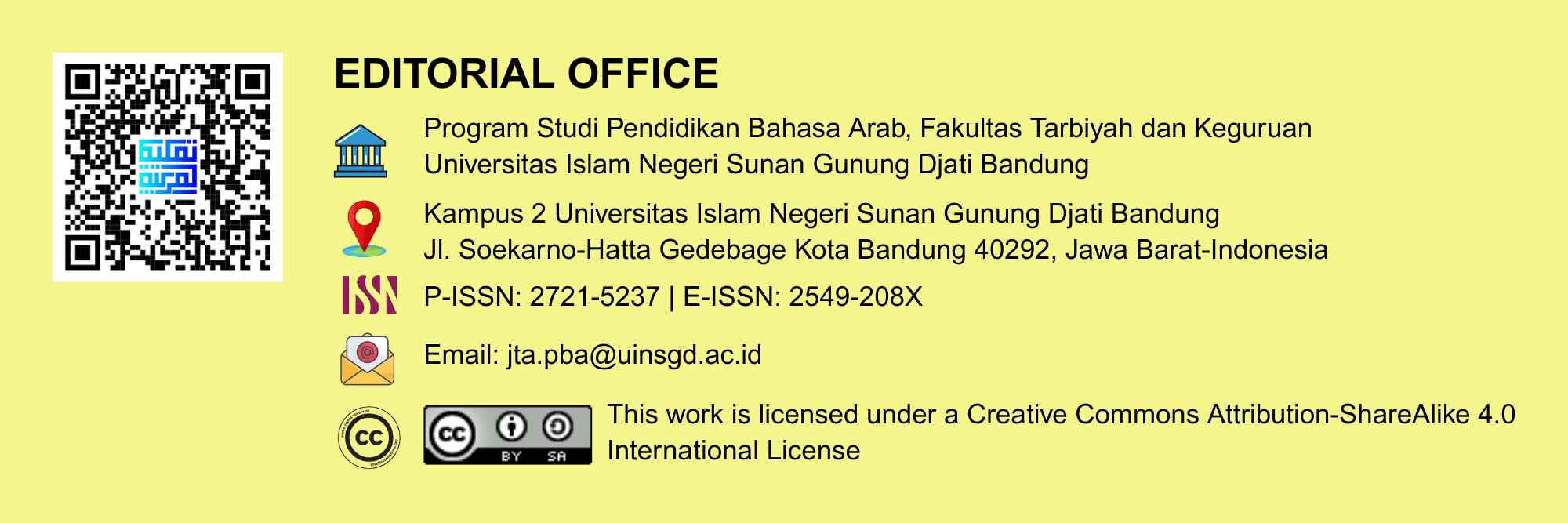The Meaning Of Weapon Lexicons In Arabic Proverbs
DOI:
https://doi.org/10.15575/jpba.v5i1.12340Abstract
This research studied the use of weapon lexicons in Arabic Proverbs (AP). The discussion aims to find the meaning interpretations of the use of weapon lexicons in AP and the moral messages reflected in there. The method used is descriptive qualitative method. The data collection was carried out by the observation method with note-taking technique. The data is obtained from the Mahfuzat Arabic Proverbs Dictionary. The results showed that there were three types of weapon used in AP, there are sword (As-saif, As-sharim), arrow (As-Sahmu, Al-Kana’in), and spear (al-Asnah). The figurative meaning of the weapon lexicons is a reflection of Arabic culture that likes to fight - in ancient times -. The moral messages contained in the AP with the weapon lexicons are 1) utilizing the time; 2) keeping the words; 3) be alert; 4) introspection; 5) creative thinking.
References
Aini, N. (2014). Penggunaan Nama-Nama Hewan dalam Perumpamaan dan Peribahasa Arab (Analisis Semantik Kognitif). Yogyakarta: Tesis pada Universitas Gadjah Mada .
Ali, N. N., & Mat Teh, K. S. (2020). Arabic Proverbs in Literary Studies and Its Similarities with Malay Proverbs. International Social Science and Humanities Journal, 3, 112.
Chaer, A. (2007). Linguistik Umum. Penerbit Rineka Cipta.
Koentjaraningrat. (2015). Pengantar Ilmu Antropologi. Jakarta: Rineka Cipta.
Kramsch, C. (1998). Language and Culture. English: Oxford University.
Manzhur, I. (2003). Lisan al-‘Arab. Cairo: Dar al-Hadits.
Nirmala, D. (2014, April). Proses Kognitif dalam Ungkapan Metaforis. Jurnal Ilmiah PAROLE, 4.
Rachmat, A. (wy). Paremia Sebagai Refleksi Budaya Dalam Bahasa Rusia. Jurnal Konferensi Linguistik Universitas Airlangga.
Rohman, A. (2009). Analisis Bentuk dan Makna dalam Peribahasa Arab. Yogyakarta: Tesis pada Universitas Gadjah Mada .
Salam, A. U.–Q. (1985). Kitab al-Silah. Beirut: Muassasah al-Risalah.
Saragih, E. L., & Mulyadi. (2020). Cognitive Semantics Analysis of Animal Proverbs in Toba Language . Retorika, 217.
Sukiman, U. (2015, Desember). Makna Figuratif Senjata dalam Idiom Bahasa Arab (Kajian Semantik). Adabiyyat, XIV, 250.
Turos, T. (2015). Kamus Peribahasa Arab Mahfuzhat. Jakarta: Turos Pustaka.
Zulhaim, R. (1982 ). Amsal al-Arabiyyah al-Qadimah (Peribahasa Arab kuno). TT: Second Edition.
Downloads
Published
How to Cite
Issue
Section
Citation Check
License
Authors who publish in Ta'lim al-'Arabiyyah: Jurnal Pendidikan Bahasa Arab dan Kebahasaaraban agree to the following terms:
- Authors retain copyright and grant the journal right of first publication with the work simultaneously licensed under a Creative Commons Attribution-ShareAlike 4.0 International (CC BY-SA 4.0) License that allows others to share the work with an acknowledgment of the work's authorship and initial publication in this journal.
- Authors are able to enter into separate, additional contractual arrangements for the non-exclusive distribution of the journal's published version of the work (e.g., post it to an institutional repository or publish it in a book), with an acknowledgment of its initial publication in this journal.
- Authors are permitted and encouraged to post their work online (e.g., in institutional repositories or on their website) prior to and during the submission process, as it can lead to productive exchanges, as well as earlier and greater citation of published work (See The Effect of Open Access).
![]()
Ta'lim al-'Arabiyyah: Jurnal Pendidikan Bahasa Arab dan Kebahasaaraban is licensed under a Creative Commons Attribution-ShareAlike 4.0 International License.
Based on a work at https://journal.uinsgd.ac.id/index.php/Talim








